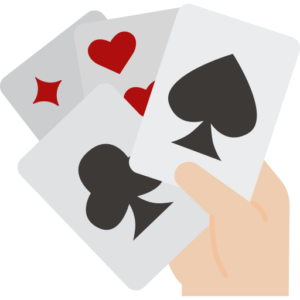Glossary Term
Gutshot
Gutshot
Used In: Poker
Introduction
In poker, a gutshot refers to a type of straight draw. It occurs when a player is one card away from completing a straight, but the missing card is located in the middle of their hand. Unlike an open-ended straight draw, where the player can hit their straight by drawing to either end of the sequence, a gutshot requires a specific card to complete the hand.
For example, if a player holds 7♠ 8♣ and the board shows 4♦ 5♠ 9♣, the player needs a 6 to complete the straight. This is a gutshot because the 6 is “inside” the sequence, not on the ends of the straight. It’s harder to hit than an open-ended straight draw, making it less likely to connect.
Gutshots are important because they influence betting decisions. While the odds of completing a gutshot are lower than an open-ended straight draw, they still offer potential value if the player can make the right move at the right time. Knowing when to chase a gutshot or fold is a key part of poker strategy.
In Depth Look
A gutshot straight draw is a poker hand where a player is missing a single card in the middle of a potential straight. It differs from an open-ended straight draw, which gives players two opportunities to complete their straight by hitting either end of the sequence. In contrast, a gutshot requires a specific card from the deck to connect the sequence, making it a lower-probability hand. For instance, if a player holds 7♠ 8♣ and the board shows 4♦ 5♠ 9♣, they would need a 6 to complete a straight. Because the player only has one card they can draw to, hitting a gutshot draw is less likely, and the pot odds must be carefully considered before chasing it.
The odds of completing a gutshot are roughly 8.5% on the turn or river, or about 1 in 11. While the straight it creates can sometimes lead to a strong hand, gutshots are generally weaker and require caution. Players often use gutshots as part of a larger strategy, where their betting behavior or position at the table could increase the chance of succeeding with a gutshot draw. However, the difficulty of completing the draw should prompt careful decision-making, especially when up against stronger hands or large pots. Understanding when to fold or continue with a gutshot draw is essential for managing risk and maximizing potential gains.
- A gutshot draw requires one specific card to complete a straight, making it harder to hit than an open-ended draw.
- The odds of hitting a gutshot draw are around 8.5%, or 1 in 11.
- Gutshots can be part of a larger strategy but should be approached with caution due to their lower probability of success.
Mechanics
A gutshot straight draw arises when a player has four consecutive cards but is missing one in the middle of the sequence. To visualize this, imagine holding a 7♠ 8♣, with the board showing 4♦ 5♠ 9♣. In this case, the player needs a 6 to complete the straight. Unlike an open-ended straight draw, where the player can complete their hand by drawing to either end of the sequence, the gutshot draw only has one card that will complete the straight. This makes the draw harder to complete and gives it lower odds of success.
The process of calculating the odds of hitting a gutshot involves counting the number of cards that can complete the hand. For a gutshot, there is typically only one card left in the deck that can form the straight. In the example of holding 7♠ 8♣, only the 6 of any suit will complete the hand, so there are four possible outs (one for each suit of the 6). When calculating these odds, players use the “rule of 4 and 2,” which estimates that you multiply the number of outs by 4 on the flop to determine the percentage chance of hitting your draw by the river, or by 2 on the turn.
After calculating the odds, players need to assess the pot odds to determine if it’s worth continuing with the gutshot. Pot odds are the ratio of the current bet to the size of the pot. If the potential reward outweighs the risk based on the odds of completing the gutshot, the player may decide to call or raise. However, because gutshots are less likely to hit than open-ended straight draws, they require careful consideration of position, stack size, and the player's read on the opponents. If the pot odds are not favorable, it is usually wise to fold and wait for a better opportunity.


Illustrated Example
Let’s take a closer look at an example of a gutshot straight draw. Imagine you're playing Texas Hold'em, and the flop comes down as 4♦ 5♠ 9♣. You hold 7♠ 8♣ in your hand. In this case, you have a gutshot straight draw. To complete your straight, you need to hit a 6 (any suit) on the turn or river. Your hand is currently incomplete, but it could become a strong one if that 6 appears. Since a gutshot straight draw only has one specific card to complete the straight, the probability of hitting that card is lower than that of an open-ended straight draw, where you have two possible outs.
Let’s calculate the odds and potential payoff. You’re facing a bet of $20, and the current pot is $100. You have four outs (the four 6s in the deck), and the probability of hitting one of those outs on the turn or river is roughly 8.5%. To determine if it's worth calling the $20 bet, you need to compare the pot odds to the odds of completing the draw. If the pot odds are favorable, it might be worth continuing. For instance, if the pot odds (the ratio of the current bet to the pot) give you a better expected return than the odds of hitting the draw, you can call. If not, folding would be the better option.
In this example, you need a 6 to complete your straight. The table shows your outs (the four 6s in the deck), the probability of hitting your gutshot (8.5%), and the pot odds (5:1). With the pot odds being more favorable than the odds of hitting your gutshot, you may consider calling the bet, depending on other factors like position and opponent tendencies.
| Your Hand | Board | Gutshot Outs | Odds of Hitting a Gutshot | Pot Size | Bet | Pot Odds |
|---|---|---|---|---|---|---|
| 7♠ 8♣ | 4♦ 5♠ 9♣ | 6♠, 6♥, 6♦, 6♣ | 8.5% | $100 | $20 | 5:1 |
Player Perspective
From the player’s perspective, deciding whether to continue with a gutshot straight draw involves balancing risk and reward. A gutshot straight draw is harder to hit than an open-ended straight draw, but it still has the potential to turn into a strong hand. The player must assess the current situation—looking at the size of the pot, the bet they face, and their own position at the table. If the pot is large and the player’s odds of completing the gutshot are favorable based on pot odds, they may decide to call the bet or even raise. However, because the probability of completing the straight is relatively low (around 8.5%), players need to be cautious and avoid chasing gutshots too often.
Another key factor is reading the table and understanding the dynamics of the hand. If the player is in a later position and can see how their opponents react to the flop, they may have more information to make a better decision. For example, if the opponents show weakness with small bets, the player might take the opportunity to continue chasing the gutshot. On the other hand, if the opponents are betting heavily, it may be a sign that they have strong hands, and the player should fold rather than risk continuing with a low-probability draw. Timing, position, and an understanding of the players at the table all play a crucial role in how the gutshot draw is approached.
Conclusion
A gutshot straight draw is a challenging yet potentially rewarding hand in poker. While the odds of hitting the required card are lower than with an open-ended straight draw, the draw still offers a chance to complete a strong hand. Players must carefully weigh the probability of completing the straight against the pot odds and the dynamics of the game. It's important not to chase a gutshot too frequently, as the odds are against you, but understanding when the situation warrants a call or raise is key to successful poker strategy.
Ultimately, mastering the gutshot draw requires both skill and patience. A player who can assess the table, understand the odds, and adjust their strategy based on the flow of the game will be better equipped to handle gutshot draws. Like many aspects of poker, success with gutshots depends not just on the cards, but on smart decision-making, timing, and an understanding of when to push for the draw and when to fold.
The Top Online Casinos for Playing Poker
These platforms prioritize player satisfaction by providing intuitive interfaces, seamless gameplay experiences, and robust security measures to ensure a fair and enjoyable environment for all users.
No results were found!


Author
Branimir Ivanov | Senior News Contributor








